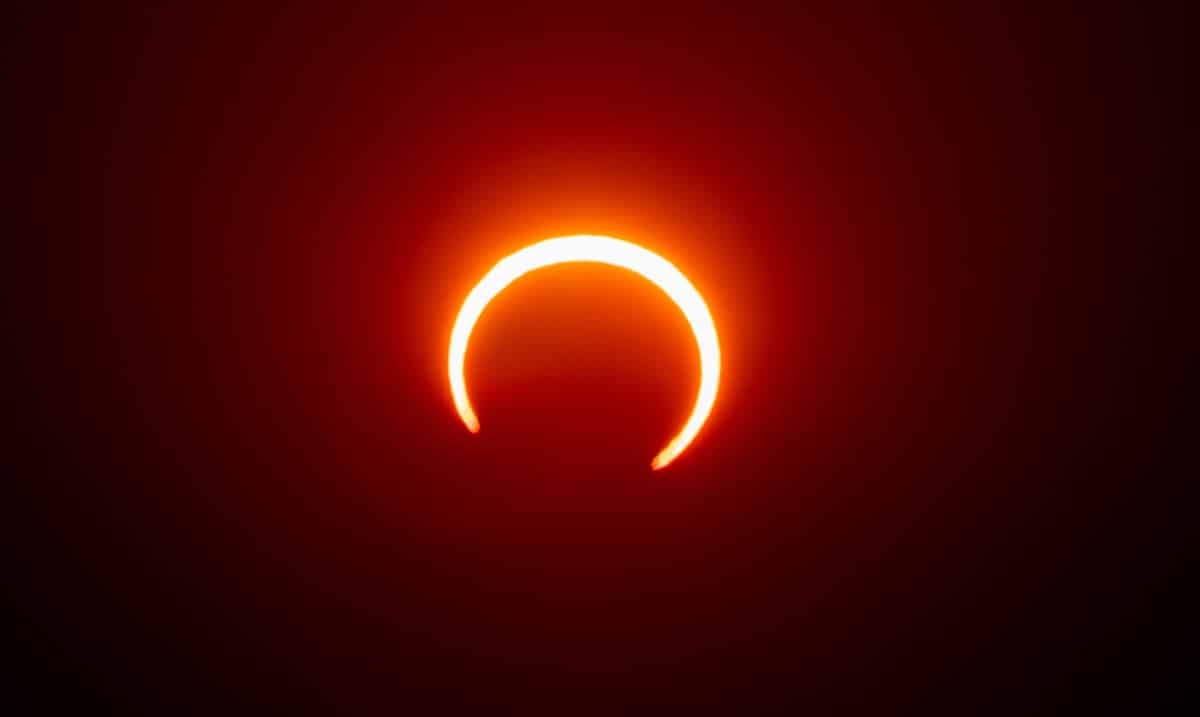Get ready for a celestial spectacle this week as the skies are set to light up with a ‘Ring of Fire’ solar eclipse. On October 14, 2024, a rare and stunning annular solar eclipse will grace parts of the world, offering skywatchers the opportunity to witness one of nature’s most captivating events. This astronomical occurrence will create a spectacular ring of sunlight, also known as the “Ring of Fire,” that you won’t want to miss.
Here’s everything you need to know about when, where, and how to experience the eclipse safely.
What Is a ‘Ring of Fire’ Solar Eclipse?
A ‘Ring of Fire’ solar eclipse happens when the Moon is at its farthest point from Earth, called apogee, and passes directly between the Earth and the Sun. Because the Moon is too far away to completely block out the Sun, it leaves a fiery ring visible around its edges. This differs from a total solar eclipse, where the Sun is completely covered.
In the case of this annular eclipse, the result will be a stunning glowing halo in the sky, creating a mesmerizing sight for those fortunate enough to be in its path.
When Will the ‘Ring of Fire’ Solar Eclipse Happen?
The ‘Ring of Fire’ solar eclipse will occur on Monday, October 14, 2024. The eclipse will begin over the Pacific Ocean and track across parts of North, Central, and South America. Those within the narrow path of annularity will experience the full eclipse, while others outside of this path will see a partial solar eclipse.
The path of annularity — where the full “ring of fire” effect will be visible — will stretch from parts of California, Texas, and parts of Central and South America. Outside of this path, much of North America will still experience a partial eclipse, which will also be an impressive sight.
Key Viewing Times for October 14, 2024
- Western United States: The eclipse will be visible from around 8:00 a.m. to 11:00 a.m. Pacific Daylight Time (PDT), with the ring of fire appearing at approximately 9:30 a.m. PDT.
- Texas: Residents in Texas can expect to see the annular eclipse around 11:00 a.m. Central Daylight Time (CDT).
- Mexico and Central America: In Mexico and further south, the eclipse will occur around midday, peaking at approximately 12:00 p.m. to 1:00 p.m. local time.
- South America: Parts of South America, including Colombia and Brazil, will witness the eclipse in the early afternoon.
Remember to check local viewing times for your specific location, as these can vary slightly depending on where you are.
How to Safely View the Solar Eclipse
Watching a solar eclipse can be an awe-inspiring experience, but it’s critical to view it safely to avoid damaging your eyes. Never look directly at the Sun without proper protection.
Here are the best methods to safely observe the event:
- Eclipse Glasses: Make sure you have certified eclipse glasses that meet the international standard for safe solar viewing. These glasses protect your eyes from the Sun’s harmful rays, allowing you to view the eclipse without injury.
- Solar Filters: If you plan to use binoculars, a telescope, or a camera, equip them with proper solar filters. These filters prevent damage to both your equipment and your eyesight.
- Pinhole Projector: A fun and simple DIY option is a pinhole projector. Using two pieces of paper, punch a small hole in one and let the sunlight pass through it onto the second paper, projecting the Sun’s image safely without having to look directly at it.
Best Locations for Viewing the ‘Ring of Fire’
If you’re hoping to see the full ‘Ring of Fire’ effect, you’ll need to be located along the narrow path of annularity. The best places for viewing this incredible event include:
- California (USA): Areas like Northern California will offer prime views, with several parks and locations preparing for special viewing events.
- Texas (USA): Cities like San Antonio and Corpus Christi are ideal for witnessing the ring of fire in its full glory.
- Yucatán Peninsula (Mexico): Another excellent spot for viewing, with clear skies and scenic backdrops to enhance the experience.
- Colombia and Brazil: Parts of South America will also enjoy spectacular views of the annular eclipse.
If you’re outside these regions, don’t worry — much of North and South America will still be treated to a partial solar eclipse, making it worth stepping outside to take in the phenomenon.
Can’t See It In Person? Watch It Live!
If you’re not located in the path of annularity or unable to catch the eclipse in person, many observatories, planetariums, and space organizations will be hosting live streams of the event. Platforms like NASA and other astronomy groups will broadcast the solar eclipse online, allowing viewers from around the world to watch this stunning event unfold.
Final Thoughts
The ‘Ring of Fire’ solar eclipse of October 14, 2024, will be a rare and unforgettable event for those fortunate enough to see it. Whether you’re viewing it in person or tuning in via live stream, it’s an opportunity to witness one of the most incredible sights in the sky. Be sure to prepare ahead of time, grab your eclipse glasses, and experience this awe-inspiring moment in history!
Mark your calendars for October 14, and don’t miss this chance to gaze up and witness the magic of the cosmos.
If you want over 200+ ideas, phrases, and text messages to drive your man wild with desire for you, make sure to check out my new program, Language of Desire. I give you step-by-step instructions and tons of exact words to use to get exactly what you both want in and out of the bedroom.
P.S. The reason so many men “pull away” from women is because
women don’t understand this naughty secret about men. . .


